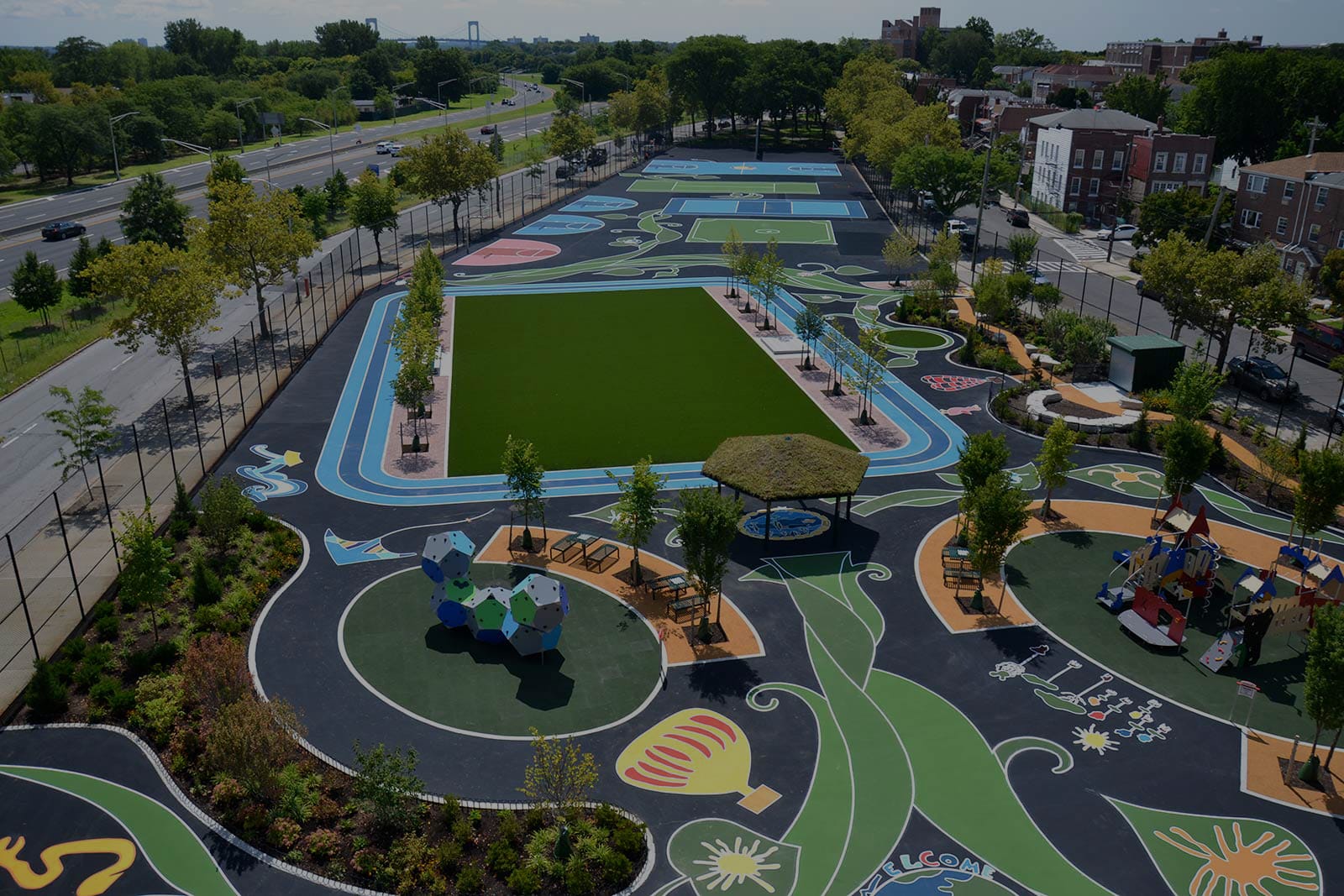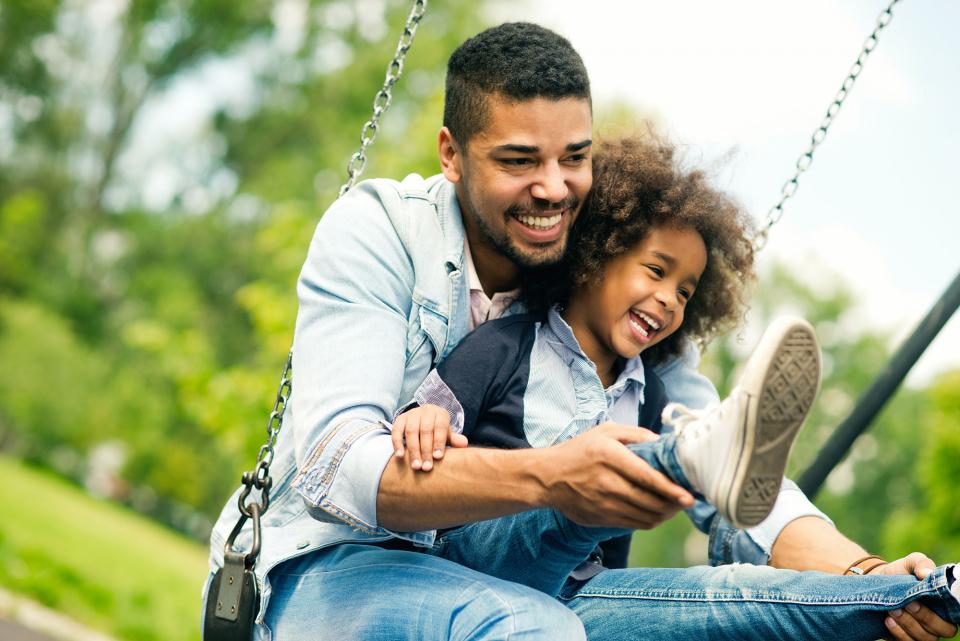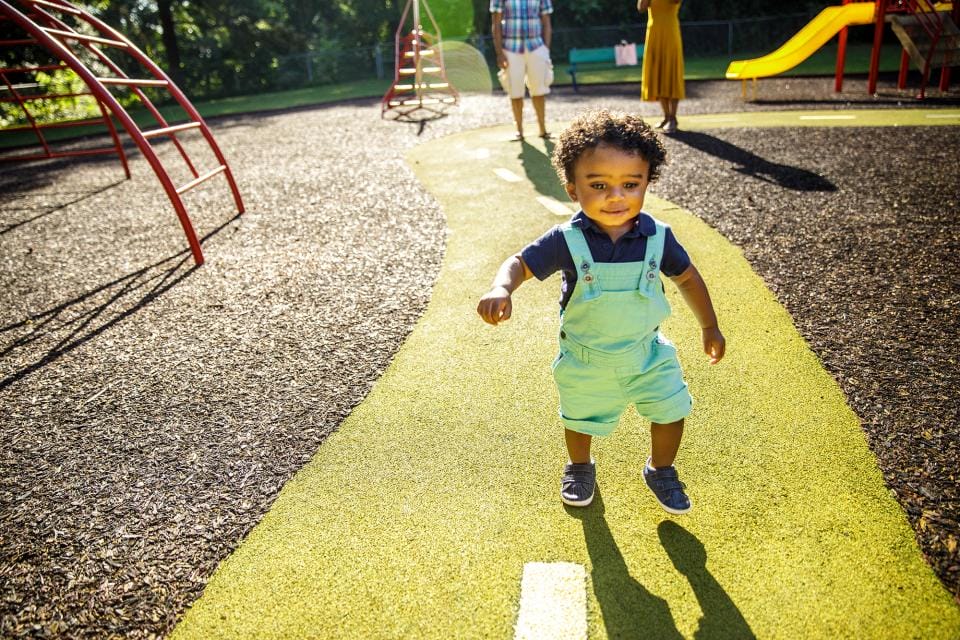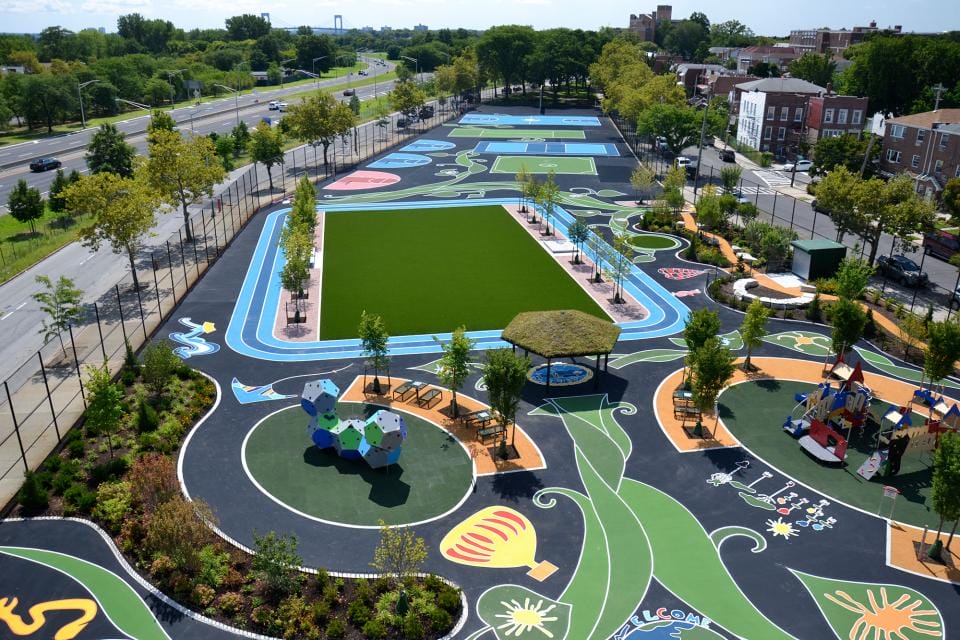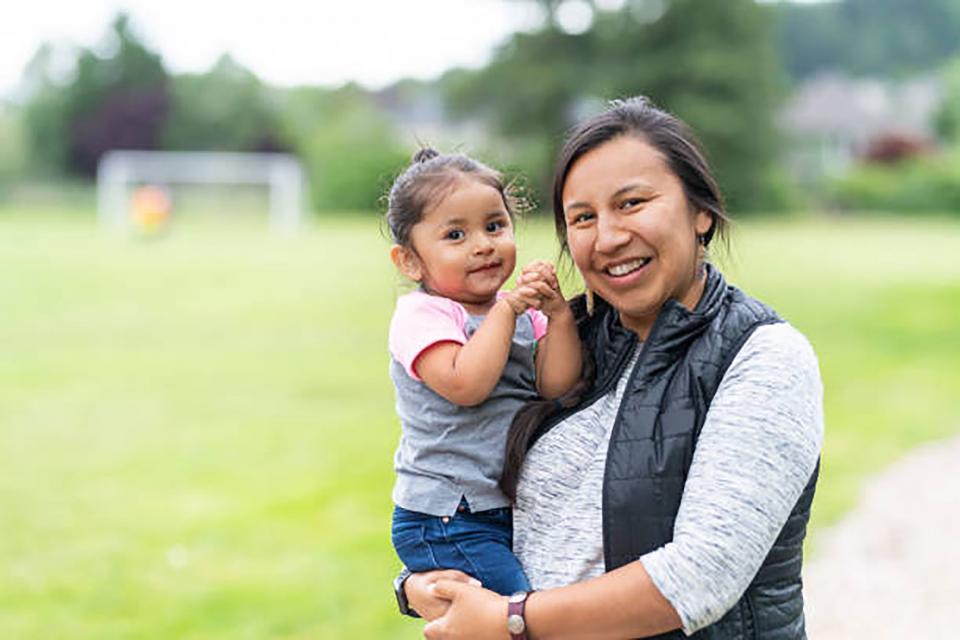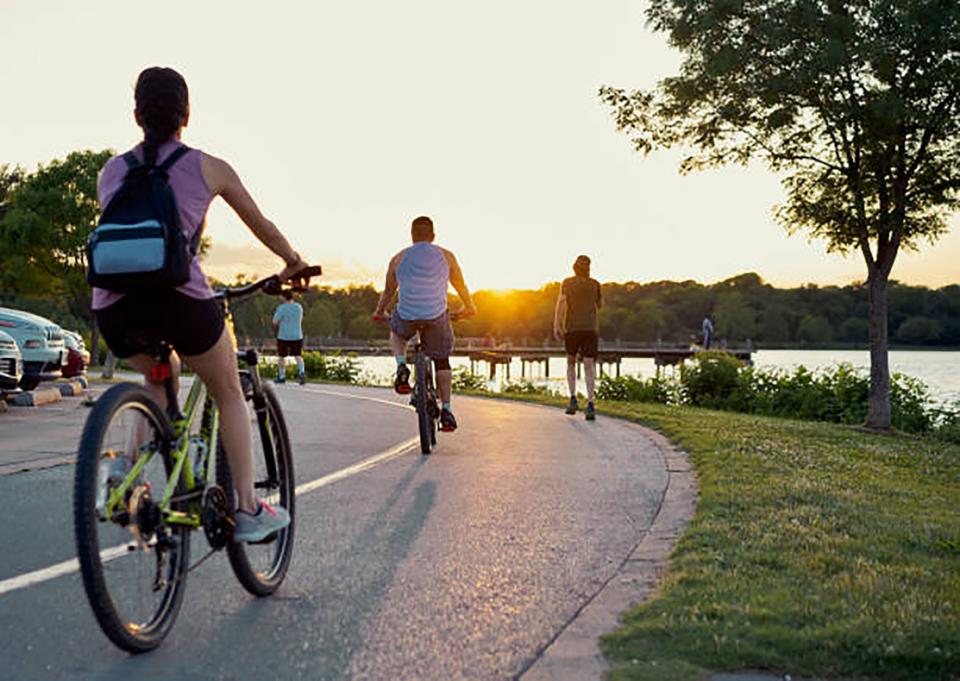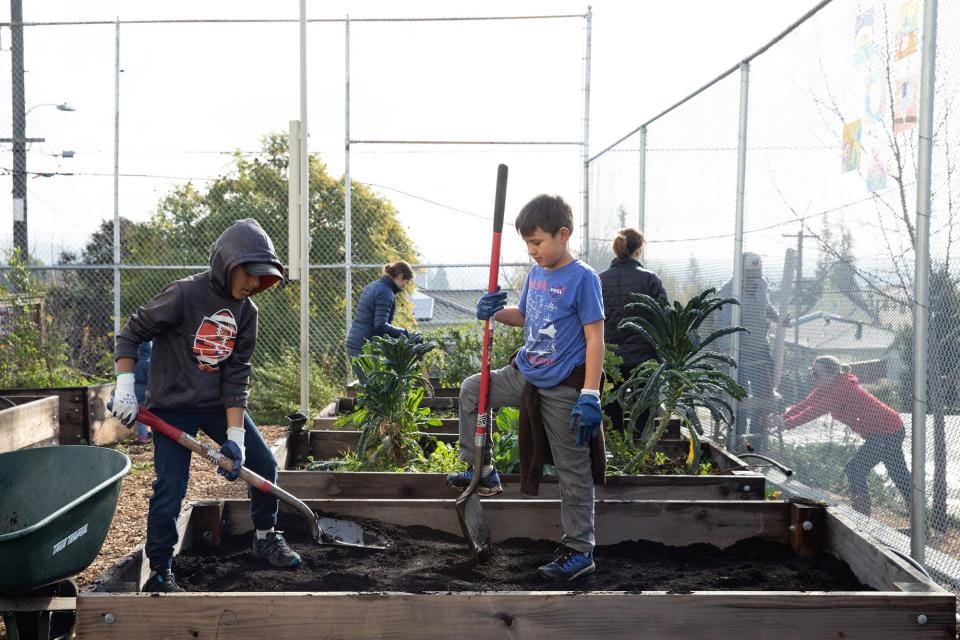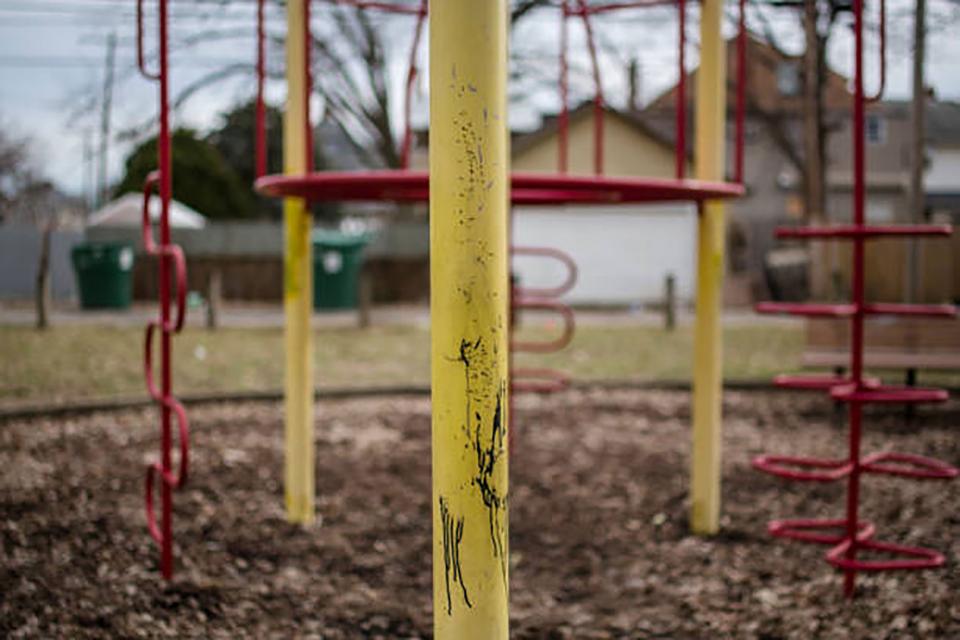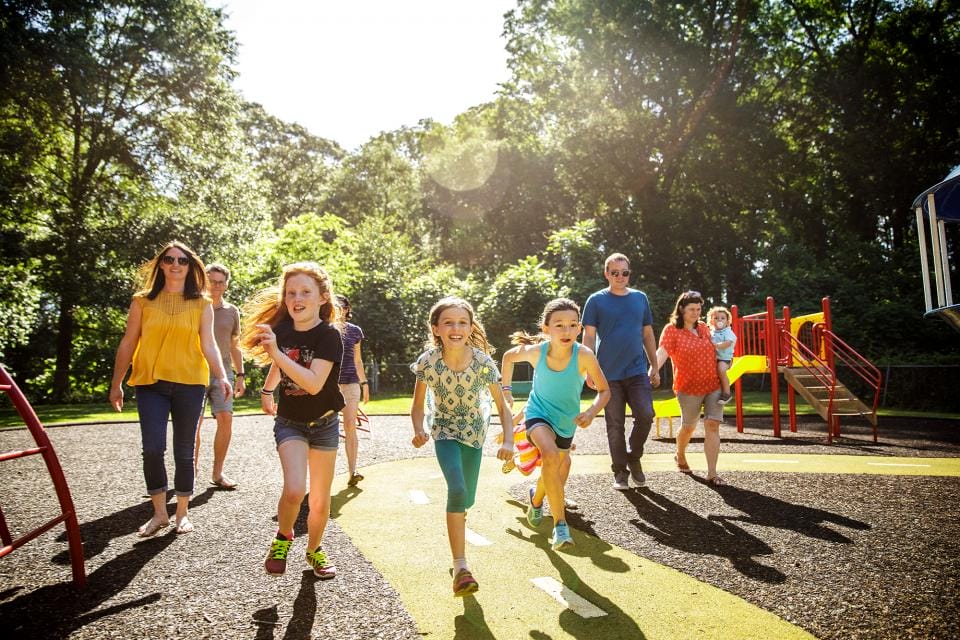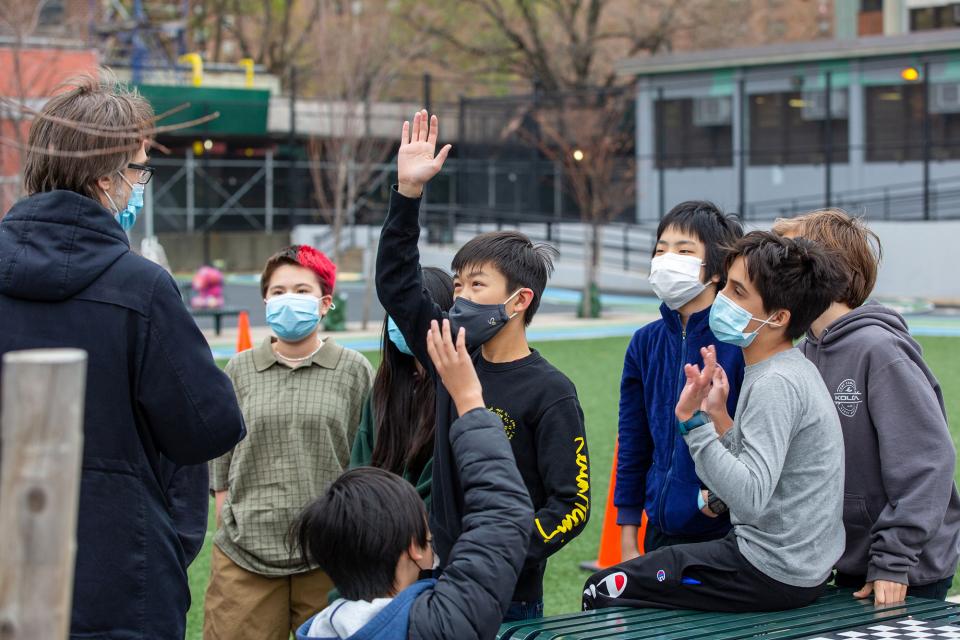This past year has proved that parks are not just a nicety—they are a necessity. As Americans endured the health and economic challenges brought on by a global pandemic, the outdoors became a lifeline.
Local parks from Washington to Tennessee to Virginia saw dramatic upticks in usage from people seeking exercise, safe social connections, and the restorative effects of nature. Parks proved their mettle as essential public infrastructure, serving as venues for everything from meal distribution to COVID tests and vaccinations to gathering spaces for protest and mourning.
[How well is your city meeting the need for parks? Explore the 2021 ParkScore rankings.]
This year also exposed vast inequities across every facet of society, including our park systems. If you lived within walking distance of a park, you could safely get outside, gather with friends, exercise, and maintain your mental health. But if you were one of the 100 million Americans who don’t have a park close to home, you were vying for the same patch of outdoor space as many of your neighbors. And as the data around access to parks shows, that was too often the case for low-income neighborhoods and communities of color, the same communities that were hit hardest by the virus.
This five-part report examines the park equity gap in America and our evolving relationship to our parks and public land during this historic crisis. Explore each section of the report below by clicking or tapping on its title.
-
By Ronda Chapman
Our data shows major disparities in access to the outdoors. In the 100 most populated cities, neighborhoods where most residents identify as Black, Hispanic and Latinx, American Indian/Alaska Native or Asian American and Pacific Islander have access to an average of 44 percent less park acreage than predominantly white neighborhoods, and similar park space inequities exist in low-income neighborhoods across cities, highlighting the urgent need to center equity in park investment and planning.
The collective traumas of the past year—from the devastating toll of the pandemic to the horrific killing of George Floyd—have reverberated through American society, prompting widespread attention and action on racialized violence, unequal access to health care, and economic stress. They have also underscored the urgent need for environmental justice and park equity.
During the pandemic, the wealthy fled urban areas for country homes, while suburbanites spread out in backyards and visited nearby parks. In too many cities, however, residents without shaded, tree-lined streets and close-to-home public green spaces found it much more challenging to get outside. Not only do parks yield all sorts of health benefits, but with COVID-19 circulating, they provided one of the few venues where people could safely socialize.
[SIGN NOW: Tell Congress to support emergency funding for local parks!]
Nationwide, 100 million people, including 28 million children, do not have a park within a 10-minute walk of home. Decades of systemic racism and redlining have led to chronic disinvestments in parks and recreational facilities in many marginalized communities, resulting in too few parks as well as parks marred by cracked asphalt, barren fields, and broken play equipment. Last year, we analyzed data from 14,000 cities, towns, and census-designated places across the United States and found that Black, American Indian/Alaska Native, Hispanic or Latinx, Asian American, Pacific Islander, and multiracial populations—when they do have parks within a 10-minute walk—are likely to find small, crowded spaces—not the kind of parks that allow for social distancing or cooling shade.
The analysis revealed that parks serving a majority people of color are, on average, half as large—45 acres compared to 87 acres—and serve nearly five times more people as parks that serve a majority-white population. It also found that parks serving primarily low-income households are, on average, four times smaller—25 acres versus 101 acres—than parks that serve a majority of high-income households.

Research shows that the way a city distributes and invests in parkland directly affects the well-being of all residents.
A new way to measure park systems
To get a more complete sense of the racial and economic disparities driving who does and doesn’t have access to quality parks and green spaces, this year, we added a new category—equity—to its annual ParkScore® index, the rating system that measures how well the 100 largest U.S. cities are meeting the need for parks.
Prior to this year, our rankings were based on just four categories: acreage, investment, amenities, and access. But research shows that the way a city distributes resources and invests in parkland directly affects the well-being of all residents. And we know that access to green space has implications for physical and mental health, as well as residents’ ability to withstand the effects of climate change, from extreme heat to flooding.
To measure park equity, we took the average of the following metrics for each of the 100 ParkScore cities:
- Percentage of people who identify as Black, American Indian/Alaska Native, Asian American, Pacific Islander, Hispanic or Latinx, other, or two or more races that live within a 10-minute walk of a public park
- Percentage of low-income households that live within a 10-minute walk of a public park
- On a per capita basis, the ratio of nearby (within a 10-minute walk) public park acres between neighborhoods that are home to people who predominantly identify as Black, American Indian/Alaska Native, Asian, Pacific Islander, Hispanic or Latinx, other, or two or more races and White neighborhoods
- On a per capita basis, the ratio of nearby (within a 10-minute walk) public park acres between low-income neighborhoods and high-income neighborhoods
Over the next several years, we will continue to update the equity evaluation by incorporating additional data, such as metrics measuring the spatial distribution of park resources (like spending and amenities) as well as data around park policies. We believe these additional metrics will give an even more precise picture of how equitably park resources are distributed in each city, to aid in decision-making for the future.
While many of the 100 cities we survey for the ParkScore index do monitor these kinds of additional metrics, not every city has the technology and human resources to collate this information today. But by adding equity to our ParkScore evaluation, we hope to support cities in making the case that they can expand their data capture as a means to improve their park systems for the communities of greatest need.
2021 park equity findings
- Across the 100 most populated cities in America, predominantly white neighborhoods average more park acreage per person than neighborhoods that are home to primarily Black, Asian American, Hispanic or Latinx, American Indian/Alaska Native, Pacific Islander, or multiracial residents.
- Seventy have more park acreage per person in predominantly white neighborhoods as compared to neighborhoods where a majority of residents identify as people of color, and 66 have more park acreage per person in high-income neighborhoods than in low-income neighborhoods.
- Neighborhoods where residents predominantly identify as people of color have access to an average of 44 percent less park acreage than predominantly white neighborhoods, and low-income neighborhoods also average 42 percent less park acreage per person than high-income neighborhoods.
- The disparity in distribution of park acreage is most significant between predominantly white neighborhoods and neighborhoods where the majority of residents identify as Hispanic or Latinx. Predominantly Hispanic/Latinx neighborhoods have access to 54 percent less park acreage per person than predominantly white neighborhoods.
Some cities, like Milwaukee, have comprehensive blueprints to redress years of neglect and unequal resources in certain neighborhoods. Pam Linn, the recreation facilities project manager for Milwaukee Recreation, is helping implement a 10-year, $25 million plan to remake the city’s 52 playfields. The recreation department, under the auspices of the city’s public schools, maintains and programs the “playfields”—basically neighborhood parks with recreational amenities. Most are located in residential neighborhoods rather than attached to schools.
Several years ago, the department hired a consultant to study their condition. “Over 60 percent of playfields were ranked ‘fair’ or ‘poor,’” said Linn in a phone interview, noting that disparities also existed based on demographics. “Where do you start?”

Neighborhoods of color have access to 44 percent less park acreage than predominantly white neighborhoods, and similar park space inequities exist in low-income neighborhoods across cities.
So recreation officials devised a plan to renovate as many of the playfields as possible. To determine which ones would go first, they decided to consider not only a playfield’s condition, but also its neighborhood characteristics, including race, income, poverty rate, and crime rate, among other things. According to U.S. Census data, in 2010 Milwaukee’s population was 40 percent Black or African American and 17 percent Hispanic or Latinx, and nearly a third of children lived in poverty.
Five renovations are now complete, two are under construction, and four more are in the design phase. One site that shot to the top of the list was Southgate Playfield, a 1.9-acre expanse of blacktop encircled by a chain-link fence. “It was so hot in the summer and there were huge cracks in the asphalt,” said Linn, a landscape architect. “You couldn’t even roller-skate. There was literally nothing you could do in that space.”
The renovation reduced the playfield’s asphalt footprint by 77 percent, with a new grass field, walking paths, and more than 30 new trees. A splashpad gives residents a place to cool off in summer, while new basketball courts are painted in whimsical colors like pale blue and peach, which don’t absorb heat as much as dark hues. There are new slides, climbing equipment, and shade structures.
“It was fantastic to watch the community embrace this new space,” Linn said of the opening day last spring.
Communities lacking quality parkland and green spaces suffer the consequences. Access to green space and time spent in nature correlate to a number of positive health outcomes: reduced stress, less depression and anxiety, improved concentration, lower obesity rates, reduced blood pressure, faster healing after surgery, and lower mortality.
Green space also makes communities more resilient to climate change by absorbing floodwater and providing much-needed tree shade. The cooling benefits of densely vegetated parks can even extend beyond their borders into the surrounding neighborhoods.
A report commissioned last year by the Hispanic Access Foundation and the Center for American Progress revealed that people of color were three times more likely to reside in nature-deprived communities than white populations.
“The United States is losing a football field’s worth of natural area every 30 seconds,” the report authors stated, adding that, annually, that equated to the size of Everglades National Park. “The effects of these losses are not equally distributed across socioeconomic and racial groups … patterns of development—including urban sprawl, the construction of roads, pipelines, and transmission lines, and drilling, mining, and logging—have had a disproportionately large impact on communities of color and low-income communities.”
A call to action: parks, jobs, and equity
To address inequity in the nation’s parks, and boost the battered economy, we are leading a coalition of more than 200 organizations, including the Sierra Club and Outdoor Afro, in urging Congress to pass the Parks, Jobs, and Equity Act. The legislation, which has bipartisan support, would make a $500 million investment in local parks.
Crucially, the money is earmarked to be distributed to redress the park equity gap. The bill specifically states that priority will be given to urban areas that “lack parks and/or outdoor recreation areas within one-half mile or a 10-minute walk” and to “high-need populations based on income, age, or other measures of vulnerability and need.”
When the legislation was introduced, Diane Regas, Trust for Public Land president and CEO, said: “Park inequity has long plagued communities across the country and over the past year, the pandemic has exacerbated glaring disparities from this lack of access. This bipartisan legislation will provide urgently needed funding to help close the outdoor access gap that contributes to unacceptable disparities in health, climate resilience, and prosperity for too many people living in America.”
We endeavor to close that gap across the country by working with communities that have been subject to long-standing environmental injustices to cocreate green spaces in neighborhoods with the least access to quality parks today.
Just south of downtown Los Angeles, in the city of South Gate, for example, we are leading efforts to convert a seven-acre, city-owned property into a nature park on the Los Angeles River, to be called the Urban Orchard. Sitting in the shadow of a busy highway, South Gate is a family-oriented community filled with local pride. At the same time, its 93,000 residents—94 percent of whom are Latinx—share their city with three Superfund sites, and as a result, their town is cloaked in air pollution, as well as industrial waste.
“When you look at our climate index, the pollution burden in South Gate is 98 percent,” said Robin Mark, our Los Angeles program director. “You have the 710 freeway that takes all the goods from the ports to the rest of the country and the residents here are inhaling all of these fumes.”
Residents wanted Urban Orchard to be a green oasis, with walking paths, an education garden, and a nature-based playground. As its name suggests, the Urban Orchard will feature more than 200 fruit trees, including avocado, guava, lemon, and lime.
The $24 million project will have a newly constructed wetland, which will capture and filter storm-water runoff that flows from points north. Currently, all that runoff sluices through a channel out to the L.A. River, adding to the pollution there. The wetland will naturally filter the runoff, which will then be used to irrigate about three-quarters of the park.

“The fruit tree species were chosen by local residents,” Mark said. “And through our partnership with the Conservation Corps of Long Beach there will be job-training on the site. Thirty young people from the community will have the opportunity to gain valuable construction skills.”
Another way to bridge the park equity gap is to better utilize existing public spaces. Our schoolyards program has transformed more than 210 school properties around the country, installing trees and gardens, new play equipment, and turf fields. The renovated schoolyards are open to the community after school and on weekends, improving park access.
[Subscribe: Get the latest news about the park equity change you help make possible.]
For example, in West Philadelphia, we are working on a Green Schoolyard project at Alain Locke Elementary School, partnering with the school district, the city, and Drexel University. The schoolyard will eventually serve more than 6,000 residents within a 10-minute walk. Of those residents, 81 percent are Black, and nearly half live in poverty. Many suffer from asthma, diabetes, heart disease, and other diseases related to inactivity. “It’s the school with the highest concentration of students living in public houses or homeless shelters,” said Owen Franklin, our Pennsylvania state director. “It’s a big schoolyard with broken pavement in a neighborhood of generational poverty.”

To close the park equity gap, we must get creative to optimize the open space we already have, in places like forgotten alleyways, postindustrial waterfronts … and asphalt-covered schoolyards.
Not far away, a green space at the corner of Mount Vernon and North 37th Streets illustrates the way park renovations can help communities long after the opening day ribbon-cutting. Completed in 2016, the renovation in the Mantua neighborhood of West Philadelphia included fresh play equipment, updated basketball courts, and newly planted trees. The park serves more than 11,000 residents, 60 percent of whom are Black, within a 10-minute walk. It also creates a platform for groups like H.U.B. Coalition Inc. and the Mantua Civic Association to provide a host of community services.
During the pandemic, community leaders activated the playground to distribute fresh food and prepared meals to those in need, particularly school-aged children. (For more than two decades, the neighborhood has not had any grocery stores.) Other partners organized arts events, including painting and puppetry workshops for children coping with feelings of isolation caused by remote learning.
And a nonprofit legal-aid organization hosts monthly Expungement Clinics at the park, offering free services aimed at expunging, or erasing, criminal records. The organization identifies candidates through monthly intake sessions in communities most affected by criminal-record data, which can make it difficult to get a job and access other opportunities.
Taken together, the services offered at this small park in one corner of Philadelphia offer a powerful example of the potential for green spaces to sustain, enrich, redress, and heal a community long burdened by social, health, and economic inequities. To me, this is what equity in parks means.
Ronda Chapman is director of equity at Trust for Public Land.
-
By Sadiya Muqueeth
Parks are widely recognized as critical for health and wellness, reducing anxiety, stress, and depression, and improving physical health. And during the pandemic, 57 of the 100 largest U.S. cities used parks for COVID testing, vaccination, or PPE distribution centers, and 70 distributed free meals, underscoring the role of parks as critical public health infrastructure, especially in times of crisis.
During the pandemic, parks provided perhaps the ultimate safety net. They were a venue to blow off steam and relax, to exercise and socialize, to meditate and grieve. They were a balm for stressed-out parents, a restorative for lonely senior citizens, and a much-needed play space for isolated, anxious children.
But parks systems also emerged as a key piece of public health infrastructure, filling the void left by shuttered schools and overburdened hospitals.
As part of our data gathering for the 2021 ParkScore® index, parks officials in 98 of the 100 largest cities reported that they had relied on parks to address many COVID-related needs. Specifically, 84 cities said they worked with their local public health staffs; 57 cities repurposed park and rec facilities for COVID-19 testing, PPE handouts, or vaccinations; 70 cities used parks for meal distribution, and 32 cities converted park and recreational facilities into alternate learning sites.
[SIGN NOW: Tell Congress to support emergency funding for local parks!]
In Miami, parks were deployed for COVID testing and vaccinations, as well as food distribution and even holiday toy giveaways—all while accommodating regular parkgoers. “We’ve had the most visitors we’ve ever seen coming through our parks,” said Chris Evans, assistant director of the city’s Parks and Recreation Department. “When everyone was eager to get out of their home and walk around, we welcomed them back into some sort of normalcy.”
Parks officials in Memphis jumped in to make sure needy families didn’t go hungry after the public schools closed last spring. Nick Walker, the city’s director of parks and neighborhoods, said that 17 community centers were put into service. By early March, those centers, which are managed by the parks department, had dispensed nearly two million meals.

Park officials in nearly every city reported that they had relied on parks to address COVID-related needs, from testing, PPE handouts, and vaccinations to meal distribution and alternate learning sites.
The usual paperwork required for the National School Lunch Program and School Breakfast Program was waived, allowing any child to obtain meals. “As the pandemic went on, we made meals available to anyone who walked up to one of our centers,” Mr. Walker said.
In addition, Memphis’s 168-acre Liberty Park became one of the busiest vaccination sites in the city, with nearly 2,000 shots administered daily. And in late February, when an unusually long cold spell led to a boil-water advisory because of low water pressure, the city’s parks staff distributed more than 100,000 bottles of water in a single day. “We keep doing different things,” Walker marveled.
For Memphis and other cities, parks are being enlisted for double duty while accommodating some of their biggest visitation in memory. It’s true that some flagship parks in major cities actually posted declines in visitors, attributable to the collapse of tourism. But many neighborhood parks experienced record numbers; more than three-quarters of the hundred cities we surveyed reported an uptick in usage in some form.
For example, during the peak months of last year, parks in Chesapeake, Virginia, posted a 29 percent increase, or one million more people than the previous year. Raleigh, North Carolina, recorded a 200 percent increase in parkgoers at specific sites. Some national parks were also inundated, despite being closed at the start of the pandemic; Yellowstone had its busiest September in history.
Nature Rx: the benefits of spending time outdoors
Numerous studies around the world have shown the positive associations between time spent in nature and our mental and physical health. Access to green space can lower stress hormones, reduce teenage obesity, boost concentration, alleviate depression and anxiety, lower blood pressure, and reduce overall mortality.
And a fascinating study in the journal Environmental Research, to be published in July, suggests that access to green space might improve COVID-19 outcomes. Specifically, the researchers looked at leaf coverage across more than 3,000 counties in the United States and then analyzed the link between exposure to vegetation and COVID mortality in the first half of 2020, adjusting for age, race, education level, home crowding, and physical inactivity.
“We found a reduced COVID-19 mortality rate with high greenspace values,” the authors concluded.

Researchers are evaluating the connection between access to green space and COVID-19 outcomes.
“We speculate that immunoregulation and reduced air pollution are likely underlying mechanisms that explain the observed association between higher levels of greenspace exposure and reduced risk of COVID-19 mortality.”
The initial closure of some parks, which occurred early in the pandemic to slow the spread of the virus, apparently took a toll on people who were already struggling with lockdown orders. When those parks reopened, some individuals had no way to reach them since they were avoiding subways and buses in order to reduce their exposure to COVID-19.
A new study in the International Journal of Environmental Research and Public Health surveyed more than 500 people in four cities last spring—Boston, Atlanta, San Francisco, and Phoenix. Nearly half of respondents said they had spent less time outdoors at the start of the pandemic, compared to the period right before. “Individuals who reported feeling nature-deprived or strongly nature-deprived since sheltering began,” the study said, “experienced a statistically significant drop in flourishing of 4.6 percent and 6.8 percent, respectively, compared to our reference group.”
The Flourishing Index is a set of questions that measure psychological well-being. Interestingly, the survey respondents said they felt even worse about being cut off from nature than they did about lost income.
Another new study out of the United Kingdom examined nature’s role in helping people cope during the pandemic. The study, published in February also in the International Journal of Environmental Research and Public Health, asked 1,184 people about their relationship to nature, as well as their health and well-being.
More than 90 percent of respondents said they had spent more time in natural environments, such as woodlands, parks, and gardens. And 97 percent said they made a point of visiting new parks and green spaces. “This suggests that people were actively seeking out new environments as a therapeutic response to COVID-19, and highlights the human appreciation for nature-centric features,” the authors wrote.
“The majority of respondents perceived natural environments as being important places for exercise, stress reduction, and anxiety reduction.”
Similarly, a study in Vermont found that women increased their engagement with nature in more ways than men. Perhaps that should come as no surprise, given that the pandemic weighed more heavily on women, many of whom stepped back from careers to help children with remote learning. In the study, women were 2.9 times more likely to report increased walking than men, and 1.7 times more likely to report increased gardening.
But as with other social determinants of health, parks and green space are not equally available. Much has been said in recent years about the role of social determinants in shaping our quality of life, even how long we live. In addition to access to nature, social determinants include access to employment and transportation; social connections; early childhood education; nutrition; literacy; discrimination, and crime. Together, these factors and conditions influence people throughout their lives, within the context of family, community, and workplace.
Social determinants have the power to bolster or hinder overall health, with outcomes invariably linked to resources and political clout. People of color, as well as those of all races and ethnicities living in poverty, often suffer from a plethora of negative determinants. A recent report on infant mortality by the Centers for Disease Control and Prevention, for example, found that 21,498 infant deaths were recorded in 2018 in the United States. That represented an infant mortality rate of 5.67 infant deaths per 1,000 live births—an all-time low. Infants of black women, however, had the highest mortality rate, at 10.75. That was more than double the rate for infants of white women, and nearly triple the rate for infants born to Asian women.
One factor in infant mortality is heat. Exposure to excessive heat has been linked in some studies to low birthweight, birth defects, and stillbirths. Low-income women may be at greater risk since they are more likely to work in hot conditions or live in urban neighborhoods with little green space and higher temperatures. Additionally, we know that times of high stress increase infant mortality and create further inequities. A 2019 study in Social Science & Medicine – Population Health looked at birth outcomes in California before and after the Great Recession, finding a correlation between the financial crisis and both preterm birth and low birthweight. Unfortunately, the current economic crisis is likely to produce similar results.
Racial and ethnic disparities also plagued the rollout of COVID-19 vaccines, which began in mid-December. By early March, the rate of vaccinations among Black people in the United States was “half that of white people,” according to an investigation by The New York Times, while the divide for Latinx people was even greater.

People who live near parks and green space not only derive the many health benefits of physical activity and time spent in nature, they also forge strong social connections.
The social determinant of park access
Access to parks and green space is one social determinant that can have a huge impact on communities.
“In my ZIP code in the city of Raleigh, the lifespan is 13 years less than a person in a ZIP code just five miles away,” said Mickey Fearn, a former professor in the School of Natural Resources at North Carolina State University and a parks, recreation, and conservation practitioner.
“It’s because of environmental injustice, which includes a whole litany of things, from toxicity and heat to lack of green space,” said Fearn, who is also a Trust for Public Land national board member. “Environmental injustice contributes more to mortality and morbidity in Black communities than any other single cause.”
[Subscribe: Get the latest news about the park equity change you help make possible.]
Conversely, people who live near parks and green space not only derive the many health benefits of physical activity and time spent in nature, they also forge strong social connections, which studies show are key to longevity. Community gardens, athletic fields, playgrounds, and dog parks—they all bring children and adults together.
Even before the pandemic, there was an epidemic of loneliness in the United States. But the virus, with its social distancing rules and work-from-home culture, exacerbated feelings of isolation. Parks were among the few places where people could safely gather during the pandemic, given that COVID-19 is much less likely to transmit outdoors.
Vivek H. Murthy, the United States Surgeon General and author of Together: The Healing Power of Human Connection in a Sometimes Lonely World, said in an interview with National Public Radio that the pandemic threatened to increase loneliness.
But he also said that the forced isolation could deepen our appreciation for human contact, sparking a “social revival,” as he put it. “If we recommit to people and to relationships, we have the opportunity to use this moment to re-center our lives on people,” he said. “And if we do that, then I believe we can come out of this pandemic more connected, more fulfilled, and more resilient than before the pandemic began.”
Brendan Fisher, a professor in the Rubenstein School of Environment and Natural Resources and the Environmental Program at the University of Vermont, last spring explored people’s motivations for visiting parkland during the pandemic. He was the senior author of a study published in December in the journal PLOS One. The study relied on the responses of hundreds of parkgoers in the Burlington area who took a quick, anonymous online survey after a hike or outing.
“Exercise” and “contemplation of nature” topped the list of reasons people sought out nature in the 25 parks. “But people also said they used parkland to socialize or spend time with family,” said Fisher. “So at a time in Vermont when we weren’t really allowed to be near other people, green space allowed them to be social—and socially distant—at the same time.”
Sadiya Muqueeth is director of community health at Trust for Public Land.
-
By Brendan Shane
From unprecedented wildfires to record hurricanes to off-the-charts heat, the past year has shown that communities don’t have time to wait for the parks and green spaces they need to keep their neighborhoods cool, resilient, and prepared for change.
The past year offered a grim look at the catastrophic future that climate scientists have been warning about for years, from unprecedented wildfires to record hurricanes to off-the-charts heat.
To make communities more resilient in the face of climate change, parks and green spaces need to be deployed deliberately in order to protect the most vulnerable. In cities, that often means bringing more parks to low-income communities and communities of color, in neighborhoods where street trees are few and parks and playgrounds are largely dominated by asphalt (which does little to provide protection from extreme heat or flooding).
In many communities, people of color and individuals below the poverty line are most vulnerable to flooding and extreme weather events. Senior citizens in high-rise public housing communities, for example, can become stranded during storms when elevator service is knocked out by power outages, leaving them without food or electricity. And in some major cities, such as New Orleans, Houston, and New York, disadvantaged communities are built in low-lying areas, putting them at risk during severe floods.
[SIGN NOW: Tell Congress to support emergency funding for local parks!]
A 2019 report from the National Academies of Sciences, Engineering, and Medicine showed that urban flooding affects a broad swath of the United States population, including wealthy people and poor people alike. But its impact is felt more acutely by Black and low-income neighborhoods, which often lack the ability to recover quickly.
Another study last year looked at insurance claims for flood damage processed by the National Flood Insurance Program from 2010 to 2019—$31 billion worth, to be exact. It found that a fifth of the claim dollars were distributed in zip codes where at least 25 percent of the population was Black, even though those zip codes constitute 13 percent of the American population.

Atlanta’s new Cook Park features green infrastructure that has the potential to soak up nine million gallons of stormwater.
Severe heat also hits people of color harder. A landmark study in the journal Climate from 2019 showed how formerly redlined neighborhoods are now 5 degrees warmer in the summer months, on average, than neighboring geographic areas. In some cities, the temperature disparity is as much as 12 degrees. Historically redlined communities today have a population profile that skews low-income and predominantly Black and Latinx.
The cooling power of dense, green spaces
In 2020, we compiled the highest-resolution heat data available for all 50 states. Our analysis revealed the striking difference in temperatures between communities that enjoy nearby parks and those that do not. Using satellite imagery for 14,000 towns and cities, our researchers found that areas within a 10-minute walk of a park can be as much as 6 degrees cooler than neighborhoods outside that range.
Green spaces cool neighborhoods by creating shade, of course. But they also lower temperatures through a process known as evapotranspiration, in which trees pull moisture from the soil and release it through leaves. The reductions in temperature, depending on tree canopy, can range up to 17 degrees, according to the National Oceanic and Atmospheric Administration. Park-deprived neighborhoods in cities therefore suffer disproportionately from heat since they tend to have less tree canopy as well as inadequate green space.
We have partnered with the Urban Drawdown Initiative, a project of the Urban Sustainability Directors Network, to work with cities from Cleveland to San Francisco to devise ways to leverage parks, woodlands, meadows, retention ponds, and urban agriculture to counter heat and absorb carbon dioxide.
“Through natural climate solutions, we are turning the paradigm of climate action upside down,” explained Brett KenCairn, senior policy advisor for climate and resilience for the city of Boulder, Colorado, and director of the Urban Drawdown Initiative. “We are saying carbon is not something bad we need to do away with, but something valuable that we need to capture and put back in living landscapes.”
As cities brace for climate change’s impacts, it is critical to layer flood mitigation onto park projects. Thoughtfully designed green spaces can soak up rising waters during major storm events through well-placed rain gardens, porous surfaces, green roofs, and retention ponds.
For example, consider Cook Park—a new state-of-the-art park we spearheaded that’s opening this spring in Atlanta’s Vine City, a neighborhood long battered by flooding. In 2002, torrential rain triggered flash floods that destroyed or damaged dozens of homes. Sixty properties had to be razed, forcing the relocation of many families. But the community is still vulnerable, sitting as it does on the edge of downtown Atlanta, which, like most city centers, is almost entirely paved.
To help prevent a recurrence of that disaster, the new 16-acre Cook Park features several examples of green infrastructure that work in concert with the park’s two-acre retention pond to manage up to nine million gallons of stormwater. Trust for Public Land program manager Jay Wozniak explained that Cook Park’s sophisticated waterworks are evidence that innovative infrastructure can be both attractive and functional. The best example of this is a feature at the southeast corner of the park. “Undoubtedly, these fountains and pools are fun to watch as their moving water drowns out the sounds of the city, but they also aerate the water and filter sediment from runoff,” Wozniak says.
Asphalt-dominated schoolyards: a magnet for heat
Newly planted trees provide much-needed shade. That is especially critical in light of research showing the outsize impact of rising temperatures on neighborhoods across America. A recent study we conducted showed the alarming effect of hotter temperatures on America’s schoolyards, the majority of which are dominated by heat-trapping pavement and concrete.
Our analysis found that nationwide, 36 percent of the nation’s 50.8 million public school students attended school in a heat island, which is defined as 1.25 degrees Fahrenheit hotter or more, on average, than the surrounding town or city. Among that group, 4.1 million students went to a school in a severe heat island of 7 degrees or more, while 1.1 million attended school in an extreme heat island of 10 degrees or more. In some communities, the heat anomaly—the difference in average temperature between the schoolyard and the city—exceeded 20 degrees.
[Subscribe: Get the latest news about the park equity change you help make possible.]
“By swapping out asphalt for trees, shrubs, and grass, we can turn down the temperature on schoolyards, which are essential spaces for children to exercise, learn, socialize, and just recharge,” said Danielle Denk, who leads our schoolyards initiative. “In addition to the neighborhood-level cooling, opening schoolyards to the public brings people together and strengthens the social infrastructure. And strong social infrastructure makes neighborhoods better prepared for contending with the climate crisis.”
As we recover from the pandemic, a period when so many Americans relied on parks and open spaces for their well-being, we need to appreciate—and build on—the potential of natural landscapes to mitigate the heat and flooding associated with climate change.
One promising development is the global momentum for a plan known as “30 by 30,” now incorporated into U.S. policy by President Biden’s Executive Order on Tackling the Climate Crisis at Home and Abroad. The idea is to conserve 30 percent of the earth’s land and 30 percent of its water in order to slow down climate change. The massive conservation effort would also safeguard three-quarters of the planet’s species.

Thirty-six percent of the nation’s 50.8 million public school students attend school in a heat island.
At Trust for Public Land, we have accelerated our own land conservation, committing to the protection of an additional one million acres by 2025. We are also seeking to create $10 billion for natural climate solutions through new voter-approved state and local public funding sources such as climate bonds.
As climate change tightens its grip on cities in the United States, urban heat islands will grow hotter and neighborhoods prone to flooding will become more so. While governments and nonprofits tackle the causes of climate change—reining in runaway carbon emissions—they must also help communities that have been marginalized to become more resilient. That means creating green spaces to absorb flood waters and adding dense vegetation to parks to mitigate extreme heat. Anything less will consign the most vulnerable to the worst effects of a warming planet.
Brendan Shane is climate director at Trust for Public Land.
-
By Linda Hwang and Jessica Sargent
Nearly two-thirds of city park departments faced budget cuts in 2020, and the fiscal environment could worsen this year. And yet, as the data shows, communities need more parks, not fewer. Cutting parks budgets actively deprioritizes public health, especially in low-income communities and communities of color, threatening progress for our park systems just when people need them the most.
In the past year, parks departments have had to do more with less like never before. During the pandemic, with movie theaters, shopping malls, sports stadiums, and other venues closed, people streamed into their local green spaces. At the same time, towns and cities converted parks to COVID-19 testing sites and, later, vaccination centers, while also using them to distribute food to the hungry.
Yet despite the surge in all kinds of use of public green spaces, park department budgets were decimated. According to our data, 63 park agencies in the 100 largest cities reported budget cuts due to COVID-19. Unlike state and national parks, city parks are especially dependent on earnings from athletic leagues and classes, as well as events like weddings, concerts, and festivals. Those activities were mostly canceled during the pandemic, leading to a sharp decline in revenues.
[SIGN NOW: Tell Congress to support emergency funding for local parks!]
All combined, that translates to an estimated $1 billion over two years in parks budget cuts in the 100 most populous cities we surveyed as part of our ParkScore® index. Nearly two-thirds of that loss represents direct cuts to city parks departments, while the remainder reflects cuts to other government agencies and nonprofits that support park and recreation facilities.
The financial losses have taken a toll, hampering agencies in their ability to maintain parks and trails amid a crush of new visitors, let alone move ahead with new projects.

Despite the surge in all kinds of use of public green spaces during the pandemic, park department budgets were decimated.
Howard Chernick, a professor of economics emeritus at Hunter College in New York, pointed out that this is not a new phenomenon; historically, parks have always been disproportionately targeted during recessions. “The story of economic cycles and the impact on parks was very much borne out in the Great Recession,” he said, referring to the slowdown following the 2008 fiscal crisis.
Dr. Chernick, who studies public finance in cities and states, worries that if the trend of remote work continues past the pandemic, property tax revenue from commercial buildings, which cities rely on to pay for services like parks, will not bounce back to pre-pandemic levels. Companies might look to save on real estate costs while employees could lobby for more flexible work arrangements. If that happens, said Chernick, “I would expect continuing pressure on parks,” adding that staff cuts lead to deferred maintenance, which leads to a backlog of more expensive capital projects.
2021 findings: parks and the economy
In our survey of cities, 63 parks departments faced a COVID-related budget cut this year or last year, averaging 10 percent but running as high as 30 percent in cities like Spokane, Washington, and Norfolk, Virginia.
The 46 cities that reported data averaged $250 million in deferred maintenance, or nearly $12 billion in aggregate. To put it in context, that is roughly equal to the entire maintenance backlog of national parks, which had more than 237 million recreation visits last year.
The last time parks budgets took such a hit was during the Great Recession. But unlike the current crisis, those effects were felt more gradually. In the years leading up to the fiscal crisis, parks benefited from robust budgets. From 2003 to 2008, for instance, park and recreation budgets grew 14.7 percent, according to an article in NRPA’s Parks & Recreation magazine entitled “The Great Recession’s Profound Impact on Parks and Recreation.” But from 2009 to 2013, spending dropped 21.2 percent.
This time, the cuts have come quickly. In the ten years since the inception of ParkScore® index, we have not witnessed another year in which parks and recreation budgets were similarly battered. So where does this leave local parks? “They’re really caught between a rock and a hard place,” said Trust for Public Land park researcher Will Klein. “Demand is higher but resources are limited, so parks are experiencing this double pressure.”
Indeed, record usage in some areas is putting pressure on parks departments that struggle to maintain play-grounds, trails, and facilities in the best of times. Breece Robertson, an expert on the use of geospatial technology for parks and conservation and author of the new book Protecting the Places We Love: Conservation Strategies for Entrusted Lands and Parks, said that during the pandemic, park users were loving green spaces to death.
”There was no year in the past decade that saw the kinds of dramatic cuts to park budgets that we are seeing now,” says Robertson, a former Trust for Public Land official, who led GIS, research and planning teams for the organization. “The problem is that parks hadn’t recovered from the Great Recession when COVID hit. Now parks are being used more than ever, and that’s creating issues with erosion, as well as wear-and-tear of play structures and other amenities.”
The most recent ParkScore data reveals the downward pressure that the Great Recession continues to exert on parks. Adjusted for inflation, public spending on city parks in the one hundred cities decreased from $126 per person in 2007 to $117 per person in 2021.
The impact of decline is exacerbated by the fact that per-person park funding already lagged behind most other public spending categories: school spending per pupil (pre-K through 12), $12,612; state and local spending on highways per person, $560; state and local spending on police protection per person, $351; and public library expenditures per person, $41.
In Oakland, California, park officials say they are deep in the red, despite hosting record crowds and serving a million meals during the pandemic. “We are underwater with a $65 million budget shortfall and we are trying to save jobs at this point,” said J. Nicholas Williams, director of Parks, Recreation, and Youth Development for the City of Oakland.
And in Louisville, Kentucky, a budget crisis in the 2019 fiscal year that stemmed from rising pension obligations left the city’s park system reeling, with a 12 percent budget cut. That was on the eve of COVID-19, which brought more fiscal pain. “There is little left to cut,” said Brooke Pardue, president and chief executive officer of the Louisville Parks Foundation. “We have concentrated most heavily on raising philanthropic dollars to counter the effects of the pandemic.”
Klein says budget cuts have led to tattered playgrounds and athletic fields, bare lawns, mounting trash, and leaky roofs. Many park agencies don’t have the funding to hire more staff and are running out of options to keep up with the increased maintenance.
The National Recreation and Park Association said park agencies were facing cuts to both operations and capital budgets, with the latter financing major new facilities and renovations. In a recent survey of municipal park agencies, a third said they had been forced to slash their capital budgets, with a median cut of 37 percent.

Record usage in some areas is putting pressure on parks departments that struggle to maintain playgrounds, trails, and facilities in the best of times.
Photo credit: Christopher T. Martin“One of the reasons that’s disturbing is that capital budgets pay for real necessities, like rebuilding playgrounds, repairing bridges, and replacing roofs,” said Kevin A. Roth, the National Recreation and Park Association’s vice president of research, evaluation, and technology. “That stuff doesn’t get better magically.”
Acknowledging park inequity
A new report from Boston University in partnership with us, The Rockefeller Foundation, and Citi suggests that despite the downturn, mayors have a new appreciation of the role of parks. The report, “Urban Parks and the Public Realm: Equity and Access in Post-Covid Cities,” is based on live interviews with 130 mayors of cities with populations over 75,000. It found that three quarters of mayors believe that once an effective vaccine is widely distributed, residents will visit parks and green spaces even more frequently than they did before the pandemic.
But the report also revealed something of a contradiction: More than two-thirds of mayors, for example, insisted that residents in their cities lived within easy walking distance of parks, regardless of race, ethnicity, or income. But at the same time, only 40 percent of mayors said the quality of green space was the same in all neighborhoods.
Katharine Lusk, co-director of the Boston University Initiative on Cities, a research center founded by the late Boston mayor Thomas Menino, said those responses showed the potential for future investment.
“In years past, mayors were reluctant to acknowledge inequity in the built environment,” she said. “And it may be the moment we’re living in, but it’s promising that mayors at least recognize the disparity in green spaces. When you think about all the investments that mayors can make, parks are where they can have a long-lasting impact on people’s lives. Mayors’ perceptions can lead to future policy and funding priorities.”
When park budgets are restored, a number of cities are prepared to make investments with an eye toward equity. Scores of cities across the United States are developing or implementing park equity plans that take into consideration not just the condition of parks, but neighborhood characteristics such as park access, income, race, air pollution, and crime.
[Subscribe: Get the latest news about the park equity change you help make possible.]
In Kentucky, the Louisville Parks Foundation is about to finance a comprehensive study that will scrutinize all 120 of the city’s public parks. The study will identify neighborhoods that don’t have a park within a 10-minute walk, or half-mile, of peoples’ homes.
But the so-called “park equitable investment” study will also rank parks according to need, so that when funding does become available, those spaces will be at the front of the line. The foundation said the murder of Breonna Taylor at the hands of the police in March of last year, and the ensuing protests, had shed light on inequities across the city.
The study is “so important to have,” said Ginger Wallace, the foundation’s director of development. “We can drive around and see parks that have atrophied over time and been neglected. And that’s one thing. But to have a study that is data-driven and has significant input from the community as well—then everyone should buy into the priorities.”
Brooke Pardue, the foundation’s president and chief executive officer, agreed. The study will ensure that the squeakiest wheels—often residents of affluent communities—don’t necessarily get the oil. “The idea is to look at our park system through the lens of equity, making sure that parks and neighborhoods with the greatest need receive the earliest investment,” she said. “Really, once you start talking about it, it’s such a no-brainer.”
Of course, future investment in Kentucky and elsewhere will depend on recovery from the current economic crisis. The first priority is to stanch the losses to parks budgets. Because of the potential for green spaces to stimulate economic activity, improve health, foster climate resilience, and build equity, cuts to parks budgets are never wise.
There is reason for optimism. Schoolyards could benefit from the $1.9 trillion American Rescue Plan recently signed into law by President Biden. That infrastructure plan is likely to direct money to schools to help them accommodate students in person. And outdoor learning—ideally on renovated schoolyards that double as community park spaces—reduces the virus’s spread. In addition, Congress is writing an infrastructure bill modeled on President Biden’s American Jobs Plan that will allow localities to tackle projects like roads, bridges, sewers, and—perhaps—parks and recreation.
Finally, we are leading a coalition of more than 200 organizations, including the Sierra Club and Outdoor Afro, in urging Congress to pass the Parks, Jobs, and Equity Act. The legislation, which has bipartisan support, would make a $500 million investment in local parks. It would not only fund 1,000 new or upgraded parks, but would save 100,000 at-risk seasonal jobs or create 8,000 new ones. Our chance at the most equitable pandemic recovery hinges on our viewing parks as the critical infrastructure they are, and supporting them accordingly.

Scores of cities are developing park equity plans that take into consideration not just the condition of parks, but neighborhood characteristics such as park access, income, race, air pollution, and crime.
Linda Hwang is director of strategy and innovation and Jessica Sargent is director of conservation economics at Trust for Public Land.
-
By Bill Lee
In too many communities, access to the outdoors is still considered a privilege when it should be a right. Now that we have the data to pinpoint where parks are most needed, the time has come to set a new standard for outdoor access and hold our elected leaders—from congressperson to councilmember—accountable for ensuring quality parks for all.
The pandemic reminded nature lovers why green space is so central to their lives, and introduced new people to the joys of parks. Others found themselves going to parks to get a test for COVID-19 or to pick up free groceries. Whatever nudged Americans into local parks, they discovered that the stress and isolation wrought by this time of global health emergency were eased by a stroll through a local woodland, a brisk walk around a running track, a hike on a nearby trail.
As we look forward to pandemic recovery, we must come together as a society to ensure that everyone is able to benefit from nearby parkland, not just the most privileged. Access to nature yields tremendous health benefits—both physical and mental—and also fosters social interaction, which research increasingly shows is key to a long life.
[SIGN NOW: Tell Congress to support emergency funding for local parks!]
Parkland is not a luxury or a nicety, but a necessity—on a par with public libraries, clean drinking water, and quality schools. Parkland is also an economic driver. A recent study found that in 2017, local park and recreation agencies supported 1.1 million jobs while generating $166 billion in economic activity. Building parks and renovating existing ones will help steer us out of the economic morass brought on by the pandemic. New parkland will also make communities more resilient, since green space counters the effects of climate change, from worsening floods to extreme heat.
One powerful way to help cities prioritize parks as the vital infrastructure they are is to push for policy change through efforts like the Parks, Jobs, and Equity Act. That bipartisan legislation would make a one-time investment of $500 million in local parks. Among other things, the money would be used to acquire land; build and renovate parks; purchase play equipment, and support programming. If enacted, the law would prioritize urban areas deprived of parkland, as well as “high-need populations based on income, age, and other measures of vulnerability and need.”
[Subscribe: Get the latest news about the park equity change you help make possible.]
“From places to sit in the shade, to spaces to exercise in the fresh air, to local job creators, urban parks bring so much value to our communities, especially during this public health emergency,” Congresswoman Nanette Diaz Barragán said when announcing the proposed legislation. “In Los Angeles County, low-income communities and communities of color often lack equal access to local parks … Now more than ever, we must support our local parks so that they can continue to serve as beloved centers of socially distanced, outdoor activities in our communities.”
At the same time that we’re pushing for more public investment, we’re also challenging the private sector to invest in equitable access to parks for all. Our Equitable Communities Fund has set an ambitious $50 million fundraising goal to energize and accelerate the efforts of historically marginalized communities to create parks and open space. This funding will be distributed across 62 communities to immediately expand access and help close the park equity gap.
The pandemic was a wake-up call about the dire consequences of inequity across our society. Emergency funding for local parks would help close the outdoor access gap that contributes to unacceptable disparities in health, climate resilience, and prosperity for too many Americans.
Bill Lee is senior vice president of policy, advocacy, and government relations at Trust for Public Land.

